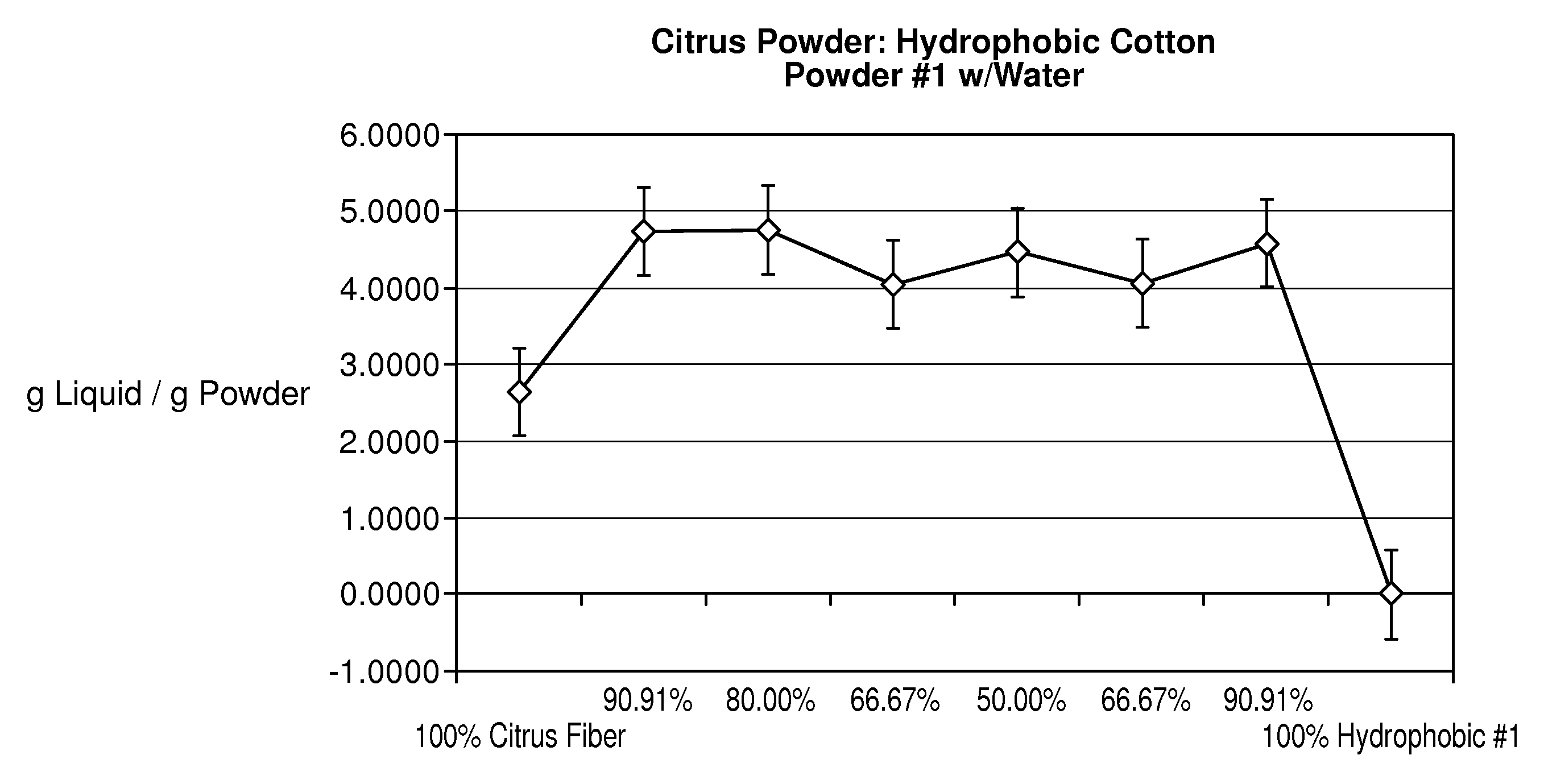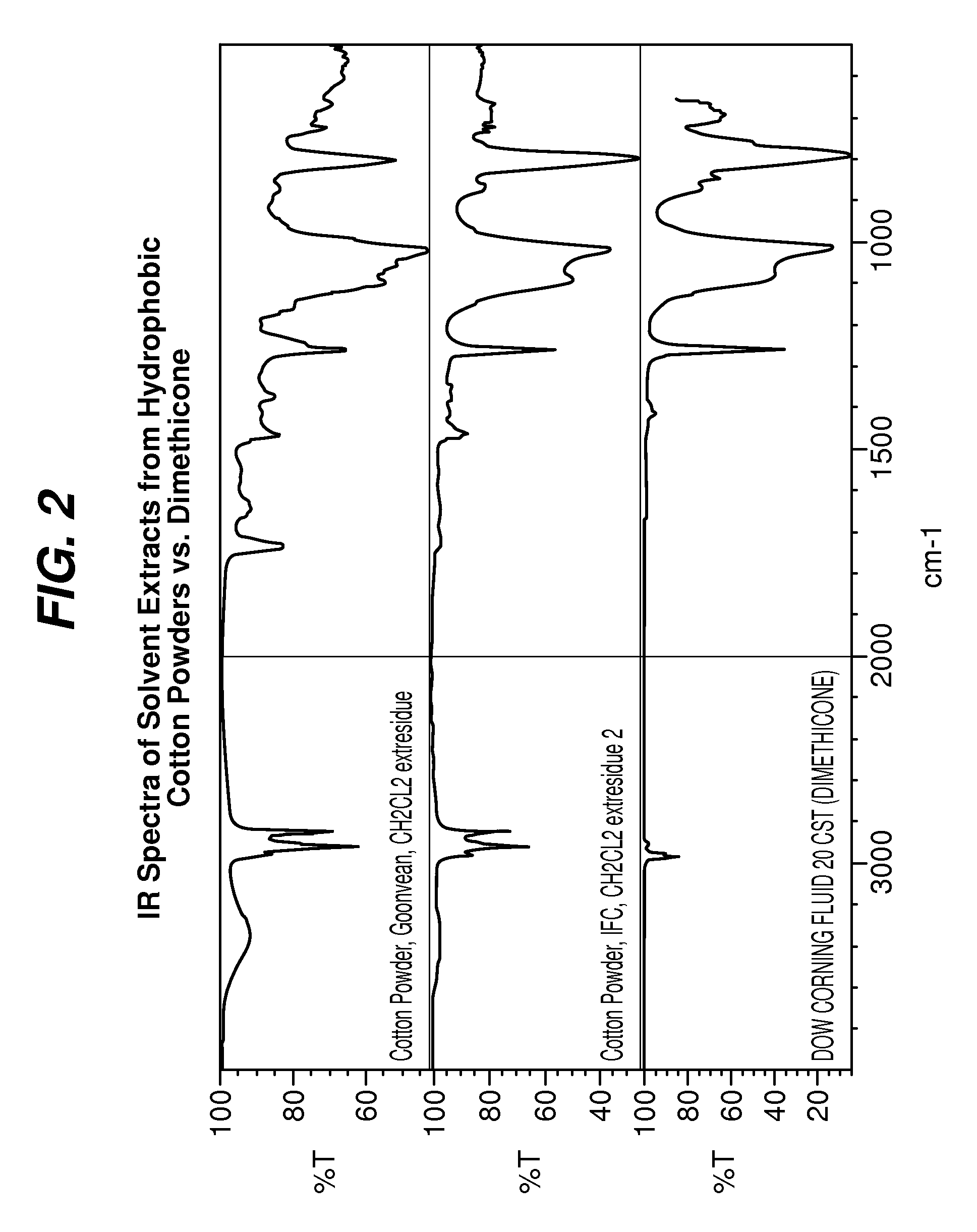Skin care compositions containing cotton and citrus-derived materials
a technology cotton and citrus, which is applied in the field of skin care compositions, can solve the problems of coarse pores, pimples and other embarrassing blemishes of oily skin, and give the skin undesirable greasy shine, etc., and achieves the effect of increasing the water absorption and retention property and fast and higher water absorption and retention properties
- Summary
- Abstract
- Description
- Claims
- Application Information
AI Technical Summary
Benefits of technology
Problems solved by technology
Method used
Image
Examples
example 1
Characterization of Hydrophobic and Hydrophilic Linear Cellulose Particles
[0199]Hydrophobic cotton particles and Hydrophilic Cotton particles listed in Table 1 below were characterized as followed:
Materials:
[0200]
TABLE 1MaterialsSqualeneDI WaterHydrophobicHydrophobic Cotton Particle #1Linear CottonParticles(available fromGoonvean ofCornwallEngland)HydrophobicHydrophobic Cotton Particle#2Linear CottonParticles(available fromIFC of NorthTonawanda, NY)HydrophilicHydrophilic Cotton Particle #1Cotton Particles(available fromResources ofNature of SouthPlainfield, NJ)CitrusCitrus ParticleParticless(available fromFiberstar Salesof River Falls,WI)
example 1a
[0201]The particle size of the cellulose materials was determined by Mie / Fraunhofer Laser Scattering method using a Malvern Hydro 2000S Particle Size Analyzer by the following procedure:[0202]1. Ensured the cell windows and lenses are clean and free from scratches.[0203]2. Flushed (using de-ionized water) and drained the accessory at least 2 times in order to eliminate any contamination from previous samples.[0204]3. Turned off the pump / stirrer and turned on the ultrasonics for 30 seconds to allow for air bubbles to dissipate.[0205]4. Filled the dispersion unit with DI water. Adjusted the pump / stirrer speed to 2100 rpm, and then turned off the pump for about 3 seconds to allow the air to dissipate. Then slowly turned the pump back on to 2100 rpm. Toped up the water in the dispersion unit to replace the volume of air displaced.[0206]5. Added 4 drops of 5% IGEPAL CA 630 (non ionic detergent) in the tank and allow dispersing before measuring the background. If ...
example 1b
[0212]The contact angles of various cellulose particles outlined in Table 1 were determined as follows:
[0213]40 Grams of the cotton particles and citrus particles shown in Table 1 were placed in a particle sample holder; the surface was compressed with a consistent force to create a smooth and compact surface of the particles. 500 μl micro syringe filled with test liquid (water), 0.52 mm needle was used to dispense and deposit 5 μl droplets on the surface. Contact Angles of the droplet on each of the cotton and citrus particle samples were measured and calculated with Video-based DataPhysics optical contact angle measuring system OCA 20 with software SCA20 from three replicate tests on each sample, results are shown in Table 3.
[0214]
TABLE 3Initial Water ContactMaterialAngle (degrees)Hydrophobic136.2(5.8)*Linear CottonParticles (#2)Hydrophilic39.1(4)*Cotton ParticlesHydrophobic122.3(3.2)*Linear CottonParticles (#1)Amphiphilic117.9(12.6)Citrus Particles*represents standar...
PUM
| Property | Measurement | Unit |
|---|---|---|
| thickness | aaaaa | aaaaa |
| length | aaaaa | aaaaa |
| particle aspect ratio | aaaaa | aaaaa |
Abstract
Description
Claims
Application Information
 Login to View More
Login to View More - R&D
- Intellectual Property
- Life Sciences
- Materials
- Tech Scout
- Unparalleled Data Quality
- Higher Quality Content
- 60% Fewer Hallucinations
Browse by: Latest US Patents, China's latest patents, Technical Efficacy Thesaurus, Application Domain, Technology Topic, Popular Technical Reports.
© 2025 PatSnap. All rights reserved.Legal|Privacy policy|Modern Slavery Act Transparency Statement|Sitemap|About US| Contact US: help@patsnap.com



